Traffic is picking up on the trail to Everest Base Camp, Nepal, as more teams are flying into Lukla. The weather continues to be good, and no serious issues have been reported.
However, similar to recent years, some fixed-wing flights between Kathmandu and Lukla are now diverted to leave from Ramechhap, a small airstrip 140 km (85 miles) five hours drive from Kathmandu with little or no existing tourist infrastructure. Helicopters still allow you to fly directly to Lukla, or even Nanache or Periche, albeit at $600 each way compared to $200 for fixed-wing flights. Climbing The Seven Summit’s Everest team flew an airplane from Kathmandu to Luka and is now in Namache.
The Everest permit tally is now 101 foreigners across eight teams. More to come.
Now, let’s move on to what they are experiencing on the trek.
Leaving Namche
 This morning, another motivating and different wake-up call from the Monastery in Namache Bazaar. This is your fourth day on the trek, and a rhythm is developing. You wake up and immediately pull on your next warm layers. You slept in your base layers because it is only a few degrees warmer inside your room than outside.
This morning, another motivating and different wake-up call from the Monastery in Namache Bazaar. This is your fourth day on the trek, and a rhythm is developing. You wake up and immediately pull on your next warm layers. You slept in your base layers because it is only a few degrees warmer inside your room than outside.
Even though you are going to the dining room, the remit calls for full-on coverage—hat, gloves, jacket, boots. Also, you know that you are expected to get to the trail almost immediately after breakfast, so just a quick trip back to the room to brush your teeth and grab your day pack, and you are off.
According to the itinerary, today is a bit of a long day. It calls for a walk from Namche at 3,440 meters/11,286 feet to Tengboche at 3,870 meters/12,664 feet, a gain of 430 meters/1,378 feet over a 9 km/5.6 miles distance. But this is deceiving, as there is a significant loss in elevation before you gain it all back and then some.
Nonetheless, you leave your teahouse in Namche and are again on the dirt trail. It’s amazing how well-worn the trail is until you realize this is their highway. All traffic in and out of Namche goes on this trail when going north: humans, beasts, everything. Since this is a national park, no vehicles are allowed, so scooters or AWD vehicles are not allowed, and even a simple bicycle is rare.
The trail flattens out after a short steep grade leaving Namche, but the view, similar to yesterday from the Everest View Hotel, is simply stunning. Ama Dablam, at 6,856 meters/22,494 feet, dominates the view. When I first saw Ama Dablam in 1997, I asked one of the Sherpas, “That’s unclimbable, right?” He smiled and said, “No.” Three years later, I summited it myself on October 26, 2000, and for the first time began considering Everest.

It’s considered one of the most beautiful mountains in the world, along with Alpamayo in Peru, the Matterhorn in Switzerland, Fitz Roy in Patagonia and a few more. Today, it is regularly climbed and, in some ways, is more crowded than Everest!

Down and Up
The trail has a few ups and downs but steadily rises with a pleasant surprise at the top of each point. Everest always captures your eye. Even though it doesn’t dominate the view like Ama, you know what it represents. After a couple of hours and passing through a few small homes or encampments where the owners have tables filled with jewelry and the like for sale, you enter the trees and begin to go down, down, down.
If you haven’t researched the trek fully this may be a surprise because you thought you had a day with a gain a few hundred meters or a bit over 1,300-feet. Ah, but this is where mountains play tricks on us.
The trail becomes more narrow, and the dirt looser. You are glad you have your trekking poles. Just as you think you have the swing of it, a yak train comes along—uphill—going faster than you are going downhill! Perspective: Mountains encourage humility.
After half an hour, you reach the bottom of this gully and most likely have lunch at a tiny lodge just before crossing a primitive bridge over the Dudh Koshi River at Phungi Tenga. You are now at 3,250 meters/10,662 feet. You dropped a bit, but whatever the metric, it felt like more, and you know you have to gain it all back before reaching Tengboche.
At this moment, you fully internalize that you are not trekking in the Rockies, not in the Alps, not in Patagonia. You are trekking in the Himalayan Mountain Range! For a moment, you pause, look ahead, behind and then down. Taking in the moment, waves of gratitude wash over you like a sea wave.
There is an alternative route to Everest Base Camp via Goyko. I took this in 2019 while climbing Island Peak and thought it was a magnificent alternative to the traditional Khumbu trail I’m covering this year. For more details, please see my Island Peak posts.
Up and Down
Crossing the bridge, you pause to admire the sheer force of the rushing water. Being Spring, this is full glacial melt, and the flow is impressive. You watch a leaf or a stick as it’s tossed around until you step back, feeling a small case of vertigo. Hmm, what will it be like at the summit, you wonder?
Back to reality, you finish crossing the bridge and look around. You are in a deep forest filled with silver fir, birch, rhododendron and juniper trees. The thickness of the forest is impressive. It’s easy to lose sight of a teammate not too far ahead or behind. But everyone stays on the dirt trail as the journey begins ever higher.
Another “ah-ha” moment is when you realize the Namche Hill was nothing compared to this, and then you understand. The Himalayas and trek to Everest Base Camp or the summit of Everest reveal themselves in simple stages. Not too fast, not too harsh–an easy progression that pulls you deeper and deeper into the journey.
The forest thins a bit as the trail hugs the ridges. At one point, water runs freely from a stream onto the hillside. A few Monks in their crimson robes are huddled around the pool. It’s unclear if they are gathering water, washing or just doing what Monks do–connecting with Mother Earth. But you take it as a good sign that the Monastery must be close—another trick.
Tengboche Monastery
The trail gains more and more elevation, and you begin to count each step. Today, you brought two liters of water and are glad that when you break through the trees, the sun is not shy about lighting the path and warming the earth. You feel the heat of the day.
And just when you think this trail might never end, a rock gate appears – seemingly out of nowhere. A gateway to where? You walk through the wide arch and enter the grounds of the Tengboche Monastery. Directly ahead is a wide grassy field. A small group of yaks are grazing, gentle with their mass and with their steps. Their bells tell everyone that this is their home and you are a visitor.
To the left rises the Monastery. It is a simple but impressively colorful structure with stone steps leading up to the inner ground and more steps to the Monastery. You take a few more steps to see for yourself but are a bit surprised to see three elder Monks standing on a porch. They are quietly talking when suddenly one erupts into a deep, bellowing laugh that echoes within the walls of the inner ground. The other Monks smile. And so do you. What a foreign life this is to you, yet somehow, it encourages a curiosity deep within.
You are now at 3,867 meters/12,687 feet. This monastery was built in 1916 as a companion to its mother monastery, the Rongbuk Monastery, in Tibet. It also serves as a gateway to Everest. In 1934, the Tengboche Monastery was destroyed by an earthquake, and in 1989, it was destroyed by fire. Both times, it was rebuilt with the generosity of volunteers.
Tomorrow, you might return for prayers as a guest inside the Monastery. The Monks are generous with their rituals and open to all who show interest, but pictures are not allowed during their prayers. But for now, your guide sends you to the bakery at the end of the grassy area for coffee and pastries. You don’t argue.
Tonight, you will walk downhill in another comfortable teahouse with a morning view you simply cannot imagine.
An Inspirational Morning
You spent a nice night at the Rivendell Lodge downhill from the Tengboche Monastery. The Rivendell is a newer and more comfortable teahouse on the trek. Some rooms have private toilets, and the dining hall is open and accessible. However, it’s the view that leaves an impression.
You went to bed early last night, around 8, while others stayed up playing cards or watching a movie on their phones after recharging them from the solar panels for 500 Rupees. It was cold again inside and out, but you were comfortable and rested as the morning sun broke through your weak curtains. It’s time to get up.
You objected at first but then leaned over on your right elbow and pulled the sad curtain aside. The window was covered in condensation. You wiped it off. And then you understood. The view was obstructed, as it usually is in the Khumbu from late afternoon into the evening, so you were told of the view but never saw it. Now there it was – Ama Dabalm up close and personal. Oh my, what a view!
Even though you have been seeing its pointy peak for the last several days, from this vantage point, you can inspect every couloir, every crack, and the Dablam itself. The sun was rising quickly, and you wanted to get THAT picture to show everyone back home.
Up and on with your trekking clothes, down jacket included and out the door. But the sun was now over the summit and into your face. You would have to settle for a memory, a memory that you would never forget.
A Prayer Before We Go Higher
For many, the ceremonies are one of the most meaningful climbing experiences in Nepal and Tibet or anywhere with Sherpas. Before one climbs a peak, there are multiple blessings, prayers, and Pujas, especially Chomolungma, aka Sagarmatha. A puja is commonly called a Puja at Base Camp, but there are others along the way. All ceremonies pray to the mountain Gods for permission to climb, forgiveness for damaging the mountain, and safety for all those climbing.
However, you can experience the serenity and inspiration of Buddhism through a quiet moment sitting still in a Monastery. You rush to get breakfast and quickly scramble the muddy, steep trail back to the Tengboche Monastery. Your goal is to observe the morning prayers by the Monks. You hustled up the stone steps, completely out of breath because you had to hike up a dirt gulley that seemed much steeper going up than it was going down the last time. There were a few other fellow observers gathered outside the huge wooden door. You remove your shoes and put them neatly aside, as do all the others.
It was quiet momentarily, and then a young Monk, maybe ten, came along. At first, he seemed sullen, but then you realized he was basically still asleep. He opened the door and quietly welcomed you into the Monastery. Your first sight was the largest Buddha you had ever seen, maybe 10 meters higher—that’s over 30 feet! It was huge and golden. The statue had a peaceful look in his eyes.
The visitors sat on Tibetan rugs to the right of the main area. It was cold. You could see your breath. You pulled your down jacket tighter, your cap over your ears, and then you tugged on your gloves. Your sock feet were cold. Now you understood the heavy crimson robes.
One by one, the Monks entered the main hall. It appeared each one had their place—seated by seniority or position. Nonetheless, everyone entered looked a bit disheveled but quickly settled onto their pillowed seat—crossed–legged, with the crimson robe covering almost all of their body except for their head.
Soon, two young Monks, perhaps ten, fourteen or sixteen years old, began serving their elders hot tea. It was a purposeful moment but not overly formal. One of the Monks sneezed. No one is offering a Gesundheit or even a Buddha Bless You.
The drum beat began without a cue, and one of the senior monks began his chant–actually a prayer. Others joined in. They created an unbelievable resonance that built as it bounced off the artfully painted walls. You close your eyes to take this moment in without the filter of sight. It is spiritual and sensory. This is one of the moments, one of these sounds that will echo within you throughout your life. Years later, you will hear the comforting murmur as you fall asleep, dreaming of a return one day.
After leaving the Monastery, you hurry back to the teahouse just as your team is leaving. Last night’s snow has turned the landscape into a wonderland. The white snow on the green pine trees provides a contrast of life and cultures that you felt as you left the Monastery.
More Blessings – Past and Present
Fresh from the Monastery, you have another ceremony ahead. For many who have climbed in the Himalayas, one of the highlights is receiving a blessing from Lama Geshe. Sadly, he passed away in February 2018. Today, Lama Nawang Paljor performs the blessing at the Pangboche Monastery.
Lama Geshe used to do it in his home with his wife and sometimes daughter. He was special to me, as I received my first blessing from him in 1997 and many more until his passing. If you did not know Lama Geshe, this made him so special–his smile, gentle touch, soft laugh, and aura made you feel like the world was in good hands. His hands were always warm, no matter how cold the room was. You simply felt better, no matter your woes, by just being near him.
We had a blessing with him before my 2011 Everest summit. Kami, Mirjam (my summit partner) and I made a point to return afterward to thank him. He was deeply touched and said rarely does anyone visit him after a climb.
It was quite a ceremony for the blessing, and waiting an hour or more was common if he was blessing another team. You wait outside in the small grass yard, surrounded by a stone wall. Perhaps a yak walks by, bells clanging in the background and the soft flutter of prayer flags overhead.
If his daughter was home, she served as organizer, ushering people out and the next team in. His wife served hot tea or milk tea and simple biscuits on a metal tray. It was a large room in his home by Sherpa standards, with benches against the walls. Lama Geshe sat behind a small desk, his back to a wall of windows, Ama Dablam in full glory, allowing the sun to shine directly into the otherwise dark room. Usually, one of the senior Sherpas, often a monk himself, would take the lead and introduce the team and the mountain they were climbing. The Sherpas knew Lama Geshe well and revered his blessing.
The puja began with the Lama quietly praying—a soft chant born hundreds of years earlier high on the Tibetan Steps. He waved a bird feather at the smoke rising from a single piece of incense, spread water droplets from time to time, and rang a bell. All of this had meanings deeply rooted in Buddhist culture.
As guests, we would sit quietly. Some would go deeply into their own mind; others would hang onto each sound and movement that was entertaining and perplexing by what the old Lama was doing. The Sherpas would sit quietly, hands in their lap. But pictures were allowed, and the quiet was often interrupted by the sound of a shutter. Lama Geshe often looked over and just smiled. He understood the modern world.
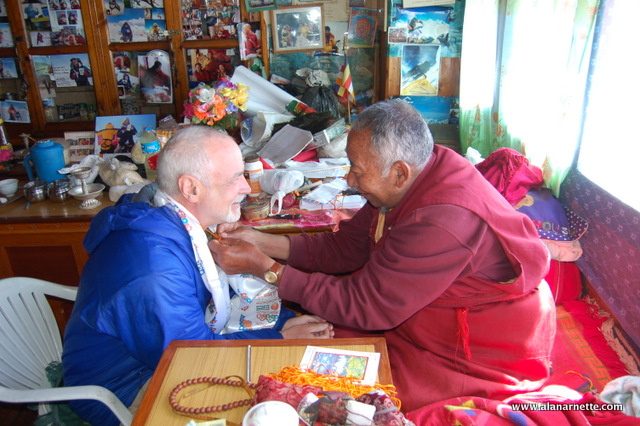
The guests were called up one by one to sit in a chair before the Lama. First, he tied a thin yellow or red string (a sungdi) around your neck. I still wear mine today. Then you gave him a silk scarf (a kata) to his daughter with an offering, maybe 100 Rupees. He would say a brief prayer, and then the scarf would be placed back around your neck. For many, he offered a gentle head bump to “seal the deal” while holding your hands, palms up. You then moved back to the bench and sat quietly while he did the same ceremony with all the other climbers and Sherpa.
The Lama would continue to chant prayers for safety and permission for those in the room to climb the mountain while tossing rice into the air. The entire ceremony lasted about 20 minutes. It was common for him to bless over 500, maybe 1,000 climbers, trekkers and Sherpa during April and May and again in September and October
Throughout the blessing, he would look you straight in the eye. The meaning was clear. This ceremony always touched me. In the quiet moments, I reflected on why I was there and what this moment and experience meant to me—I still do today.
Some people walk away with tears, others with huge smiles and some with no expression, struggling to understand. I miss my friend.

There will be one more puja at Base Camp before you climb, which is the most meaningful one for many people.
On to Dingboche
Leaving Pangboche, the trail continues to gain elevation. You left the trees a little while ago and are now trekking and fully exposed to the elements. The wind picks up on an open, flat area. You are glad for all your layers, and add your Buff to help cope with the cold, dry air. You continue to follow the Dudhi Kosi and cross it as you take the right path of a huge ridge that seems to divide east from what, or maybe north from south. At this point, all you know is to follow the path.
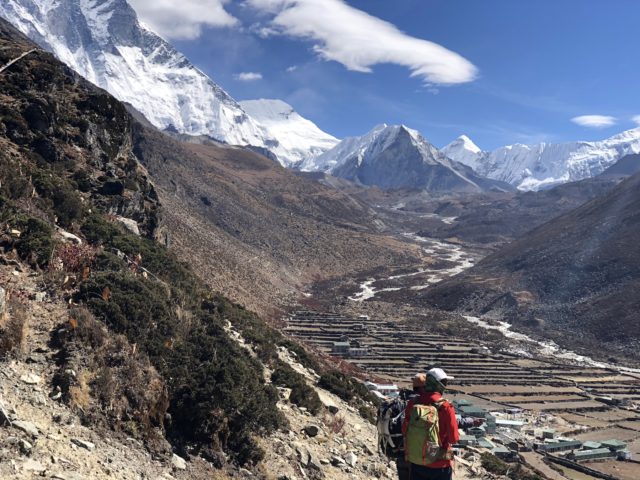
Arriving in Dingboche, you find a more primitive and remote village. In the distance, you can see the back of Lhotse and the front of Island Peak. Namche spoiled you, but understand the higher villages are respites for summer yak herders, seasonal trekkers, and climbers. No matter, you are grateful when your guide announces you have arrived at your lodge for the evening and that they have WiFi!
The air feels thinner. The stubs of grass smell sweeter. The yak bells are softer. As the cold air tickets your lungs, you know you are doing something special—something you never dreamed you would.
Climb On!
Alan
Memories are Everything
The Podcast on alanarnette.com
You can listen to #everest2024 podcasts on Spotify, Apple Podcast, Breaker, Google Podcasts, Pocket Casts, RadioPublic, Anchor, and more. Just search for “alan arnette” on your favorite podcast platform.
Preparing for Everest is more than Training
If you dream of climbing mountains but are unsure how to start or reach your next level, from a Colorado 14er to Rainier, Everest, or even K2, we can help. Summit Coach is a consulting service that helps aspiring climbers worldwide achieve their goals through a personalized set of consulting services based on Alan Arnette’s 30 years of high-altitude mountain experience and 30 years as a business executive. Please see our prices and services on the Summit Coach website.

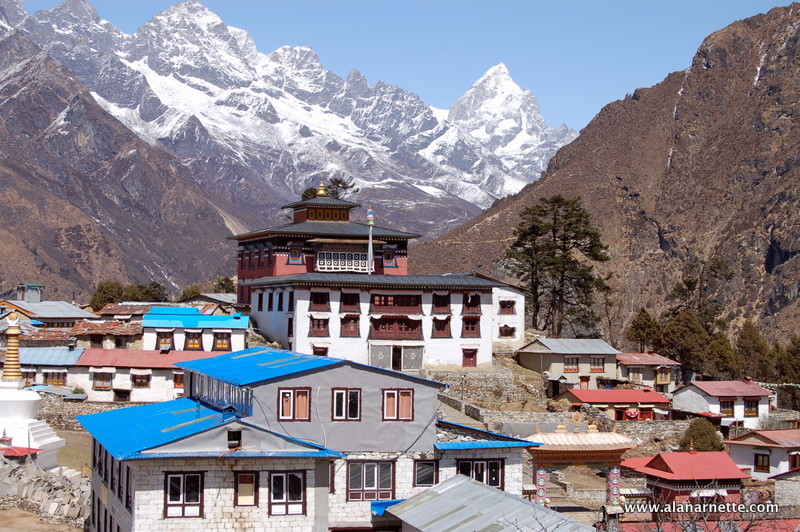


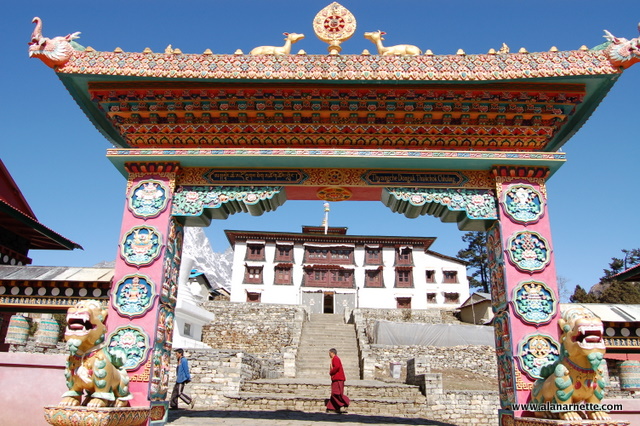

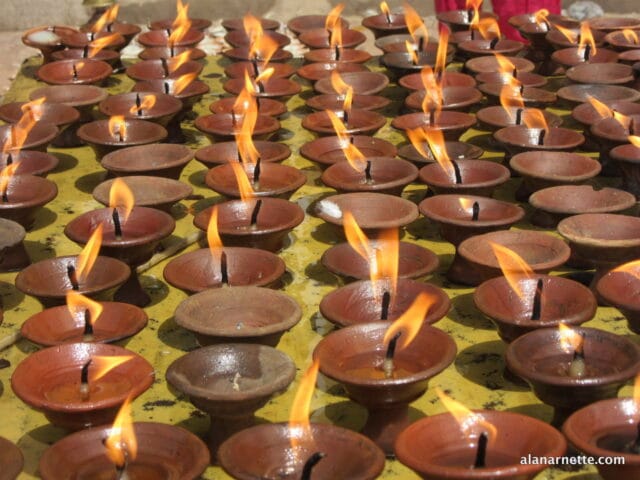






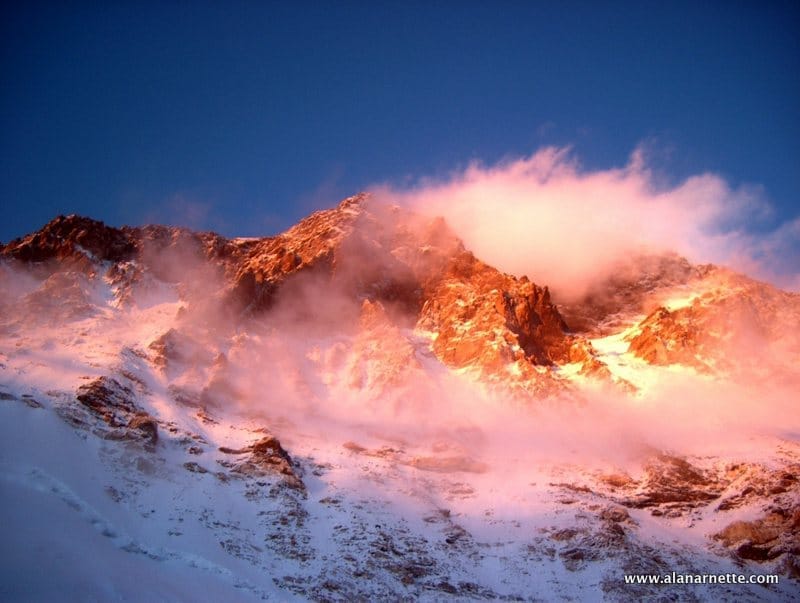
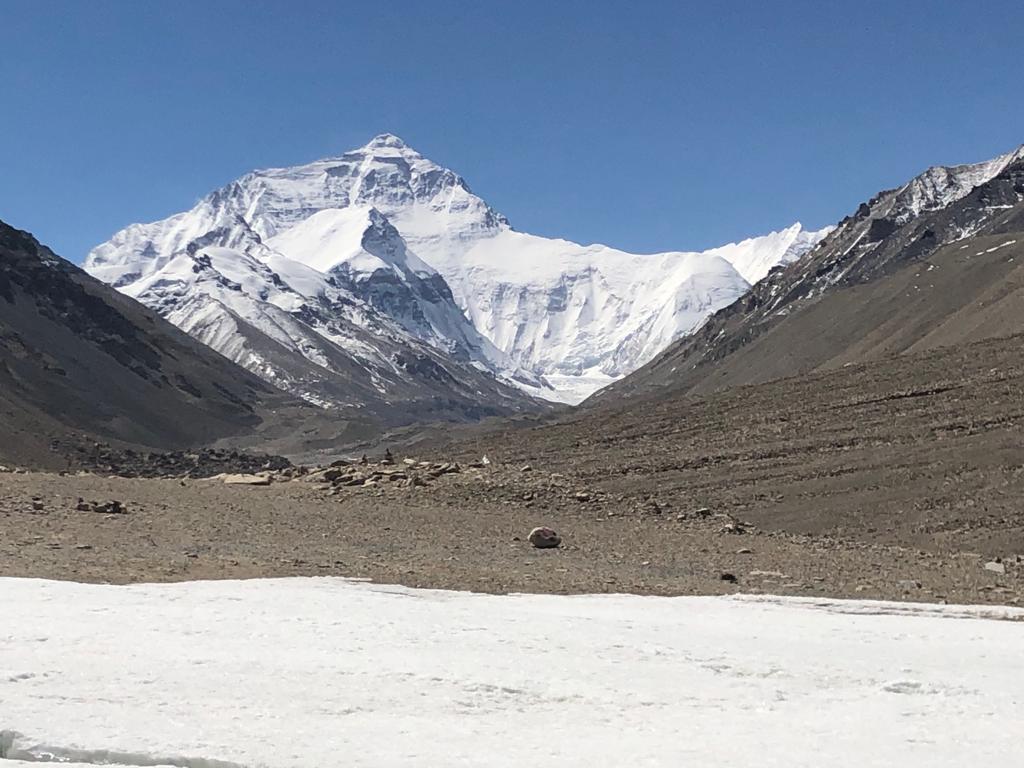
5 thoughts on “Everest 2024: Blessings on the Trek to Tengboche Monastery”
Oh Alan, thank you….I almost felt as if I was there. So appreciate you!!
This is a wonderful series. I will never do the trek or climb Everest, but your narration almost puts me there. Thank you
As an Everest arm chair enthusiast & casual hiker , I look forward to the season & following along through your blog ! Just the absolute best Alan !
Love that description of yourself Sandi as I fall in the exact same category.
Keep it up Alan!
I loved this one. Love getting to experience it piece by piece through your words. And also really enjoyed the Ama Dablam comment from ‘97 haha. Thanks Alan!
Comments are closed.